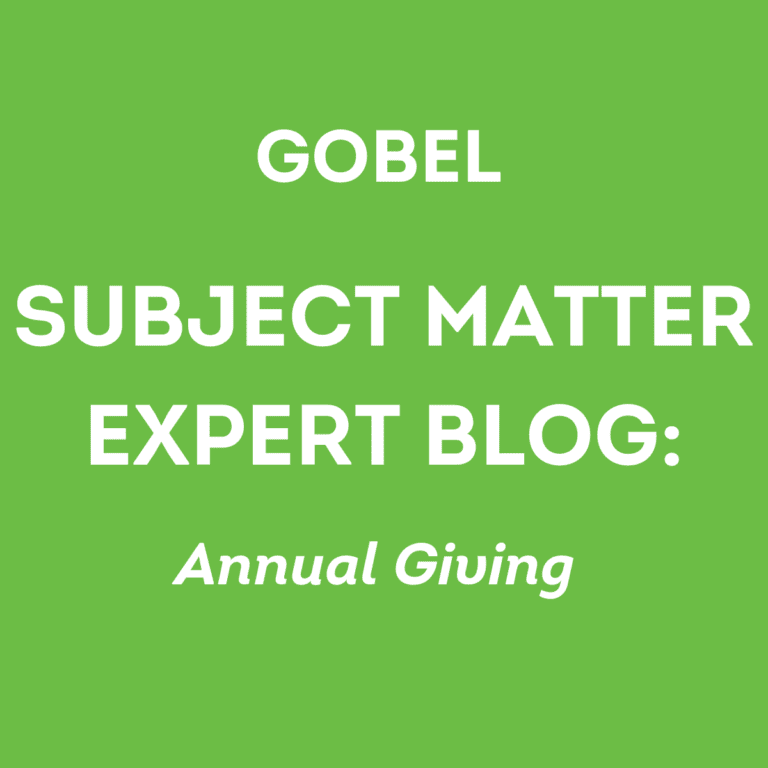
GOBEL Subject Matter Expert Blog: We Love A Good Plan
By Ann Fisher
Director of Annual Giving, Leadership Annual Giving and Data Services, Michigan Medicine
February is the month of love, and everyone has their own love language. For annual giving professionals, our love language takes the form of the annual giving plan. Nothing makes my heart sing like setting a solid plan for the next fiscal year. For most of us, whose fiscal years are on a July to June schedule, now is the perfect time to begin planning.
When I first started in annual giving, calendars often took the form of Excel spreadsheets, with all the different channels mapped out month by month in technicolored glory. For the longest time I could never understand why my major gifts colleagues and most of my leadership never appreciated my lovely plans. Once I worked on a few major gifts I figured it out. I defy anyone to put major gift work into a calendar. Mr. Smith, Mrs. Jones, and the Wilsons could be September, Ms. Hopkins could be October, while the Morris Family could be December — you get the point.
I have found that for leadership giving and major gifts colleagues it is often best to provide more of an executive summary of my plans at the beginning of the year, and then follow up with quarterly updates in the same format. I understand now that the annual plan is for team use, that it is better to give others a version that is more digestible.
But for annual giving, developing an annual schedule of activities is a critical part of what we do. It not only helps us with efficiency, but it allows us to see where we have peaks and valleys in communicating with our donors. This way we can ensure there is no oversaturation for our audiences, while also making sure that they hear from us enough. The plan also gives us a visual means of making sure we are not only utilizing all our channels but maximizing them by coordinating them around each other to achieve effectiveness. Annual plans also allow us to look for potential roadblocks or barriers that might keep appeals from happening on time.
If you are newer to this and wondering what should be in an annual plan, let’s break it down. Before you start heading down the road, you need to go where you are going, right? So, the first thing you need to do is determine what your goals are. For example, if your goal is to get more donors, you need to make sure you have enough acquisition and retention appeals built into the plan. If your goal is more focused on revenue, are your appeals targeting donors specifically geared toward getting upgrades or recurring gifts? With your goals in mind, you can start to build your roadmap. At the bare minimum, the roadmap (aka annual giving plan) should contain all the appeals for the year and details like the channel, the start data, end date, and target audiences. But it could drill down to finer details like actual tasks to complete each appeal project.
For smaller organizations, sometimes an Excel sheet is still the best option as a tool to construct your plan. But for larger, more complex organizations there are project management tools like Trello or Asana that can be used to break down our plans, imputing all the various steps in getting your various projects to their drop dates on time. In my opinion, project management tools have been a game changer in annual giving. It is amazing to be able to not only see the whole plan, but also all the various details that go into each appeal to make sure that everything is on track. Another benefit for larger organizations where several people may be involved in creating an appeal: project management systems allow you to assign out duties and provide timelines to keep everyone on track.
Again, an Excel document for your organization might be enough. It is important to have the right tools that fit your needs. Currently, my team and I use both. Assuming you have the right tools, and you are ready to plan, why now? You might feel like February is a bit too early. How can we possibly know what is coming? Eighty percent or more of your annual giving plan does not change from year to year, so it can be set any time. By planning early, you have all the known activities set and can always modify the plan based off new needs or analysis closer to the start of the new year. Starting early is also makes sure your first appeals happen on schedule.
If you feel like your annual giving efforts are a mad scramble, then learn to speak the annual giving love language. Pick the right tools to help you plan, start early, review and modify the plan as needed closer to fiscal year start, and share with collaborators so you have buy-in, and you will have a smooth flowing year of annual giving.
ABOUT GOBEL SUBJECT MATTER EXPERTS: GOBEL Subject Matter Experts are healthcare philanthropy professionals working in some of the top shops in the country, sharing best practices and insights. For more information about GOBEL’s Subject Matter Expert program, or to suggest a topic for coverage, email erezsnyak@gobelgroup.com.
ABOUT THE AUTHOR: Ann Fisher is a fundraising professional with more than 25 years of experience in annual giving. Ann began her career at Hospice of Michigan where she developed numerous skills from data base management to grant and appeals writing. From there she moved on to University of Detroit Mercy where she spend nearly 20 years in annual giving, eventually becoming their Executive Director of Annual Giving and Data Services. During her time at Detroit Mercy, Ann was instrumental in introducing new initiatives like online giving and crowdfunding while also improving the ROI in phone and mail and coordinating the University’s President’s Cabinet leadership giving program. Ann then spent two years at UC San Diego as Senior Director of Integrated Marketing, where she launched their first Day of Giving and restarted their grateful patient giving program. Ann currently works at Michigan Medicine where she serves as Director of Annual Giving, Leadership Annual Giving and Data Services. In 2021 Ann and her colleagues were selected as CASE Platinum Award Finalists in the Best Practices in Fundraising Award for their Nurses Week Campaign, which raised over $80,000 from 1,300 donors during the height of the pandemic. She has also served as a judge for the CASE Circle of Excellence Awards. In her spare time, Ann is an avid runner and has run several half and full marathons as a charity runner to raise money for various causes.

